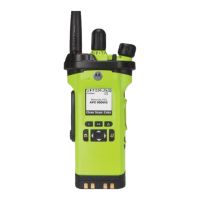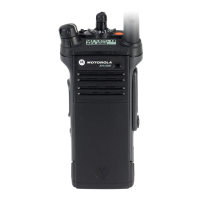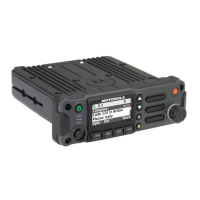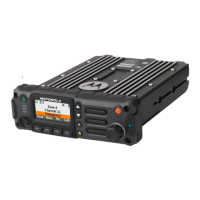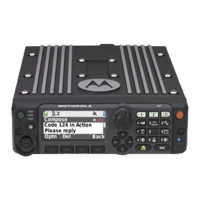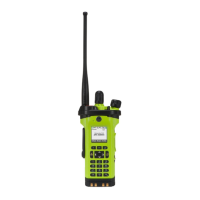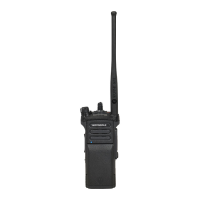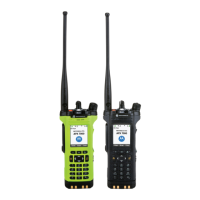3-18 Theory of Operation: Main Board
Q756 and surrounding circuitry is a buffer that provides the correct drive level to the receiver section
(via the transmission line RX_LO) and to the input to the TX buffer (Q774 and surrounding circuitry).
Q745 and surrounding circuitry provide the bias to the buffer. The buffer formed by Q756 and its
associated circuitry is called a “pre-buffer” at this stage.
R703, R704 and R707 help provide some extra isolation to the receiver.
Q774 and surrounding circuitry is the transmit injection buffer. The transmit injection buffer provide
the correct drive level to the transmitter section (via the transmission line TX_INJ). Q767 and
surrounding circuitry provide the bias to the transmit injection buffer.
VHF: The voltage-controlled oscillators are varactor tuned. The voltage (0.3V–10.6V) varies as it is
being applied to varactors D3206 to D3209 and D3246 to D3249 of their respective Voltage-
Controlled Oscillator (VCO). The capacitance of the varactors also varies, thereby changing the
output frequency of the VCOs. Both the VCOs are used to cover the entire 38 MHz bandwidth of the
VHF, 136 MHz to 174 MHz band.
• TX VCO covers the transmit frequencies from 136 MHz to 174 MHz
• RX VCO covers the receive Local Oscillator (LO) frequencies from 245.65 MHz to 283.65 MHz
The TX VCO and the RX VCO are selected using GPO1 and GPO2 respectively.
To select the VHF RX VCO, pin E5 (GPO1_TEST1) must be at a high logic level and pin D5
(GPO2_TEST2) must be at a low logic level. The output of the RX VCO is then fed to pin 5 (RF2) of
switch U3238. The output of U3238 is then split into two signals. One to the Prescaler buffer input
and the other to the prebuffer. The output of the prebuffer is then fed to pin 1 (RFC) of U738. The
output of U738, pin 5 (RF2) then goes to the attenuator (comprised of R703, R704 and R707) and
then fed to the receiver section via the RX_LO transmission line.
To select the VHF TX VCO, pin D5 (GPO2_TEST2) must be at a high logic level and pin E5
(GPO1_TEST1) must be at a low logic level. The output of the TX VCO is then fed to pin 4 (RF1) of
switch U3238. The output of U3238 is then split into two signals. One to the Prescaler buffer input
and the other to the prebuffer. The output of the prebuffer is then fed to pin 1 (RFC) of U738. The
output of U738, pin 4 (RF1) then goes to the transmit injection buffer (comprised of Q774 and
surrounding circuitry). The output of the transmit buffer, then goes to the transmit section via the
TX_INJ transmission line.
UHF1: The voltage-controlled oscillators are varactor tuned. The voltage (0.3V–10.6V) varies as it is
being applied to varactors D3102 to D3105 and D3135 to D3138 of their respective Voltage-
Controlled Oscillator (VCO). The capacitance of the varactors also varies, thereby changing the
output frequency of the VCOs. Both the VCOs are used to cover the entire 90MHz bandwidth of the
UHF range 1, 380 MHz to 470 MHz band.
• TX VCO covers the transmit frequencies from 380 MHz to 470 MHz
• RX VCO covers the receive Local Oscillator (LO) frequencies from 489.65 MHz to 579.65 MHz
The TX VCO and the RX VCO are selected using GPO1 and GPO2 respectively.
To select the UHF RX VCO, pin E5 (GPO1_TEST1) must be at a high logic level and pin D5
(GPO2_TEST2) must be at a low logic level. The output of the RX VCO is then fed to pin 5 (RF2) of
switch U3001. The output of U3001 is then split into two signals. One to the Prescaler buffer input
and the other to the prebuffer. The output of the prebuffer is then fed to pin 1 (RFC) of U738. The
output of U738, pin 5 (RF2) then goes to the attenuator (comprised of R703, R704 and R707) and
then fed to the receiver section via the RX_LO transmission line.
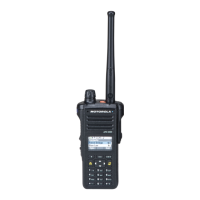
